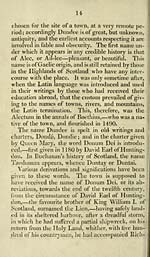Towns > Dundee > 1822 - Dundee delineated; or, A history and description of that town, its institutions, manufactures and commerce
(15)
Download files
Complete book:
Individual page:
Thumbnail gallery: Grid view | List view

15
ard I. of England (Cceur de Lion) in the third cru-
sade. Earl David resolving, probably in conse-
quence of a vow, to express his gratitude, either
wholly built, or at least made additions to, the
church which at present is used as the parish church.
He erected the stupendous square tower at the west
end, and dedicated the whole to the Virgin Mary,
by whose intercession, according to the belief of
those times of gross superstition, he imagined he
had been preserved. Though this church must
have been in the open fields at that time ; yet the
town was of considerable extent to the eastward ;
and it was certainly bestowed in a grant to the Earl
by King William, who had vowed that the first land
at which his favourite brother should arrive should
be conferred on him.
The other names, Taodunum, Dun Tay, or Dun-
tai, signify the hill of Tay, or the hill of God. The
latter meaning, taken in conjunction with Alec,
seems anciently to have given rise to the common
appellation of Bonny Dundee. That the name is
originally from the Gaelic language, with the Latin
corruption, is rendered more probable, because most
of the places in the vicinity of the town are derived
from that language, as Dudhope, Balgay, Drum-
geith, Dimtrune, Baldovie, Balumbie : few only be-
ing from the Saxon language.
The extent of the ancient royalty of Dundee was
confined within a very narrow compass. The town
appears to have consisted of two streets — the Sea-
gate, or more properly Seagaet, next the river, and
Cowgate, a little north from that, running east and
west, nearly parallel to one another ; bounded on
b 2
ard I. of England (Cceur de Lion) in the third cru-
sade. Earl David resolving, probably in conse-
quence of a vow, to express his gratitude, either
wholly built, or at least made additions to, the
church which at present is used as the parish church.
He erected the stupendous square tower at the west
end, and dedicated the whole to the Virgin Mary,
by whose intercession, according to the belief of
those times of gross superstition, he imagined he
had been preserved. Though this church must
have been in the open fields at that time ; yet the
town was of considerable extent to the eastward ;
and it was certainly bestowed in a grant to the Earl
by King William, who had vowed that the first land
at which his favourite brother should arrive should
be conferred on him.
The other names, Taodunum, Dun Tay, or Dun-
tai, signify the hill of Tay, or the hill of God. The
latter meaning, taken in conjunction with Alec,
seems anciently to have given rise to the common
appellation of Bonny Dundee. That the name is
originally from the Gaelic language, with the Latin
corruption, is rendered more probable, because most
of the places in the vicinity of the town are derived
from that language, as Dudhope, Balgay, Drum-
geith, Dimtrune, Baldovie, Balumbie : few only be-
ing from the Saxon language.
The extent of the ancient royalty of Dundee was
confined within a very narrow compass. The town
appears to have consisted of two streets — the Sea-
gate, or more properly Seagaet, next the river, and
Cowgate, a little north from that, running east and
west, nearly parallel to one another ; bounded on
b 2
Set display mode to: Large image | Transcription
Images and transcriptions on this page, including medium image downloads, may be used under the Creative Commons Attribution 4.0 International Licence unless otherwise stated. ![]()
| Scottish Post Office Directories > Towns > Dundee > Dundee delineated; or, A history and description of that town, its institutions, manufactures and commerce > (15) |
|---|
| Permanent URL | https://digital.nls.uk/85824211 |
|---|
| Description | Directories of individual Scottish towns and their suburbs. |
|---|
| Description | Around 700 Scottish directories published annually by the Post Office or private publishers between 1773 and 1911. Most of Scotland covered, with a focus on Edinburgh, Glasgow, Dundee and Aberdeen. Most volumes include a general directory (A-Z by surname), street directory (A-Z by street) and trade directory (A-Z by trade). |
|---|


